County Fermanagh is dominated by two lakes – Lower Lough Erne and Upper Lough Erne – connected by a narrow waterway at the county capital, Enniskillen.
Upper Lough Erne, the smaller of the two waters, wends towards the town from the southern hills in a maze of inlets and watery corridors. Lower Lough Erne, or Broad Lough, somewhat paradoxically, sits to the north of the town. Larger than its neighbour, it fans out across Fermanagh’s emerald countryside to within a stone’s throw of the Atlantic Ocean.
Combined, the lakes stretch out for 64km (40 miles), covering a surface area 10 times that of Windermere and draining a region almost twice the size of Luxembourg.
Our guide to County Fermanagh includes the best lakes to visit, days out, places to stay, boat trips and walks.

England’s Lake District is justifiably revered, as are the picturesque llyns of Wales and Scotland’s innumerable lochs. But could it be that the British Isles’ true Lake District is here in Fermanagh – a county half-bathed in water, home to effervescent locals, quiet country roads and romantic estates?
Related articles
Best towns and villages to visit in County Fermanagh
Enniskillen

This historic market town, built on an island between Upper and Lower Lough Erne, is the ideal base for exploring Fermanagh. It’s the county’s largest and most vibrant settlement, where pretty townhouses rub shoulders with traditional pubs and vivacious cafés. For beer, drop into traditional pub Blakes of the Hollow, then head downstairs for fine dining at Café Merlot.
Belleek

On the banks of the River Erne in northern Fermanagh, this alternative to Enniskillen will suit those seeking more peace. At the heart of the village is Belleek Pottery, a neo-Georgian building home to Ireland’s oldest working fine china company, established in 1857. Take a tour of the workshop (£6, belleek.com) then take refreshments at The Thatch Coffee Shop on Main Street (0286 865 8181).
Places to visit in Count Fermanagh – history and heritage
Hare Krishna Island (Inis Rath), Upper Lough Erne
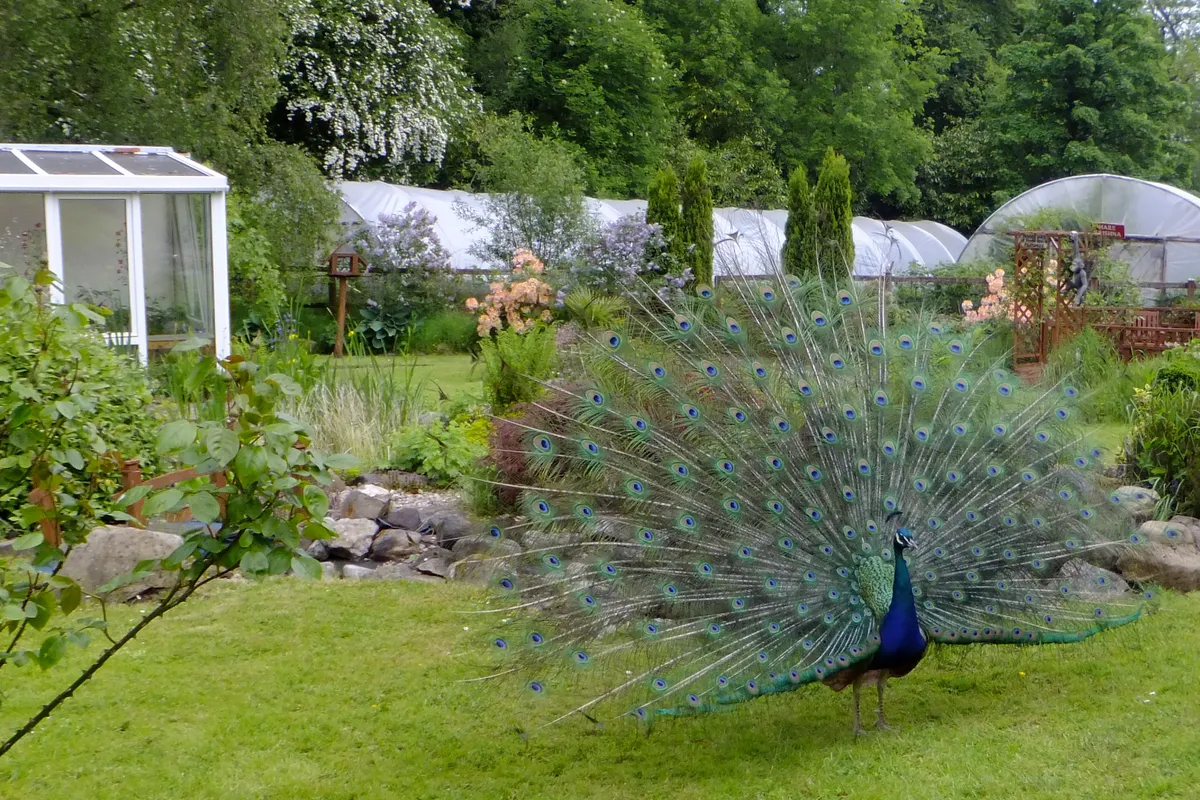
In the middle of Hare Krishna Island is a grand Victorian mansion at the head of a sweeping glade. The building was once a hunting lodge, built in 1854 by Sir Henry Cavendish Butler, but in 1982, a group of Hare Krishna monks bought the island. It is now a place of tranquillity. The exotic cry of a peacock echoes through the kitchen gardens, deer forage along the wood’s sun-warmed verges and the mansion’s west wing, now a temple devoted to Lord Krishna, sings with the heady smell of incense and the call for prayer.
The best time to visit is on Sunday when a free ferry service takes visitors to the island reserve from Geaglum Quay on Upper Lough Erne’s western shore. Time your visit with the ‘Sunday Feast’ and take part in congregational chanting, a Q&A session and a vegetarian banquet. 0286 772 3878, krishnaisland.com
Crom Estate, Upper Lough Erne
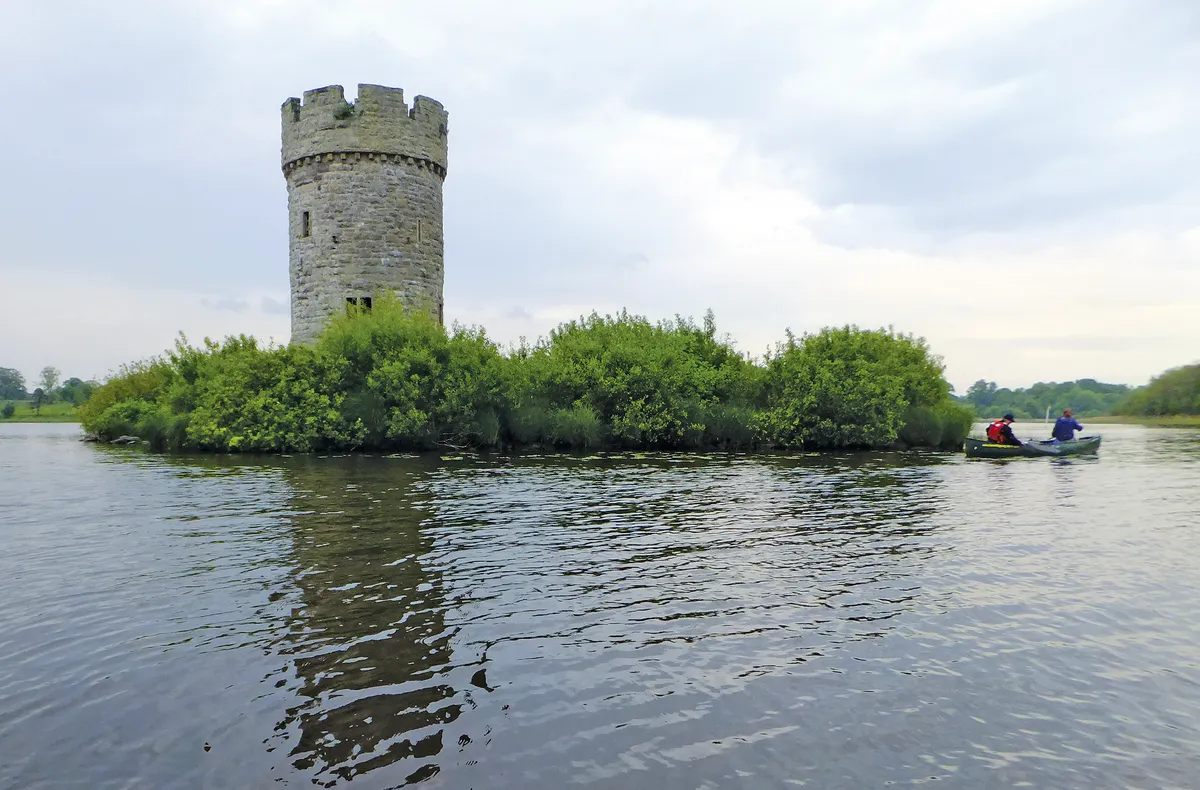
There are over 400 species of plants to be found among the woodland, parkland and castle ruins of Crom Estate, including purple loosestrife, yellow flag iris and the rare bird’s-nest orchid. Look out for spring butterflies and 12 species of dragonflies and damsels, along with bats, red squirrels and pine martens. 0286 773 8118,
Castle Coole, Enniskillen

Neoclassical Castle Coole has been home to the Lowry-Corry family since it was built in the 1790s. Experience what life was like for the family and servants on a guided tour through the kitchen, reception rooms and service quarters, then explore Lough Coole on a 2km walk. 0286 632 2690,
Florence Court, near Enniskillen
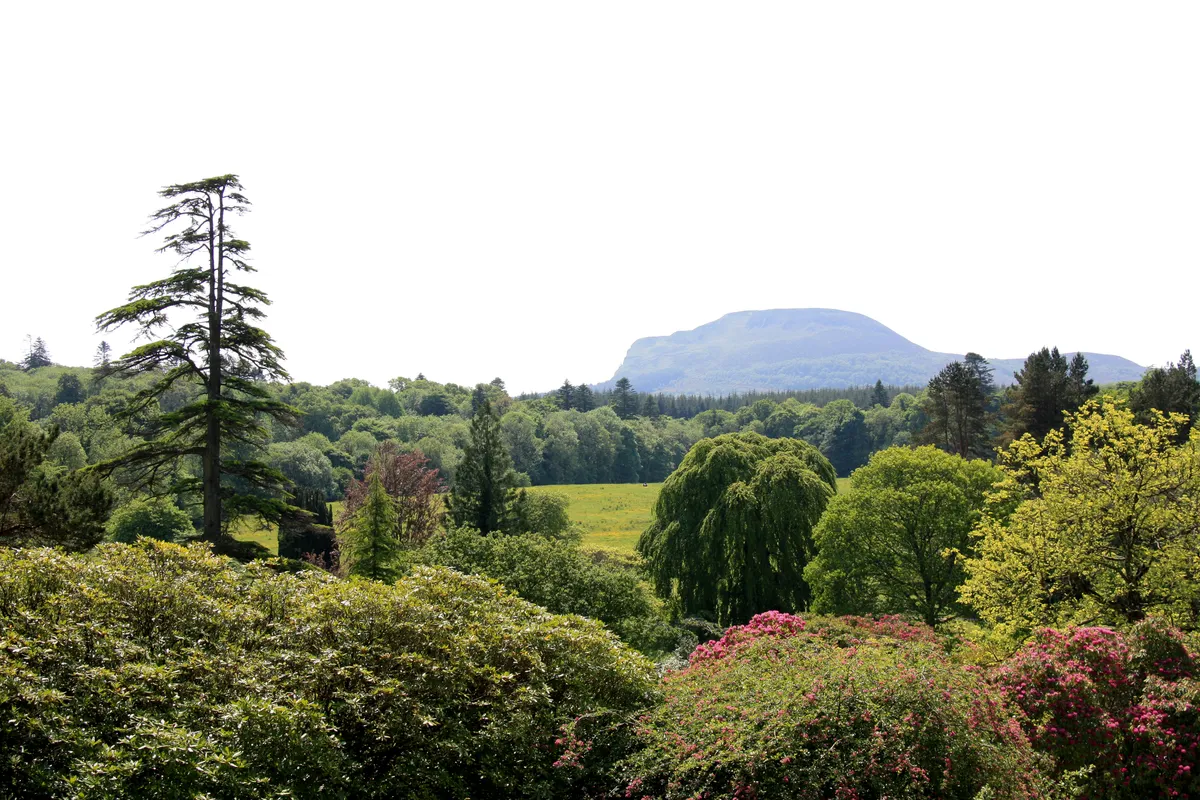
Hidden within the wooded grounds of this Georgian mansion is the mother of all Irish yew trees – a specimen planted at Florence Court more than 250 years ago. There’s also the ice house, carpenter’s shop and 1930s walled garden to be discovered, along with forest trails. 0286 634 8249,
Belleek Pottery, Belleek
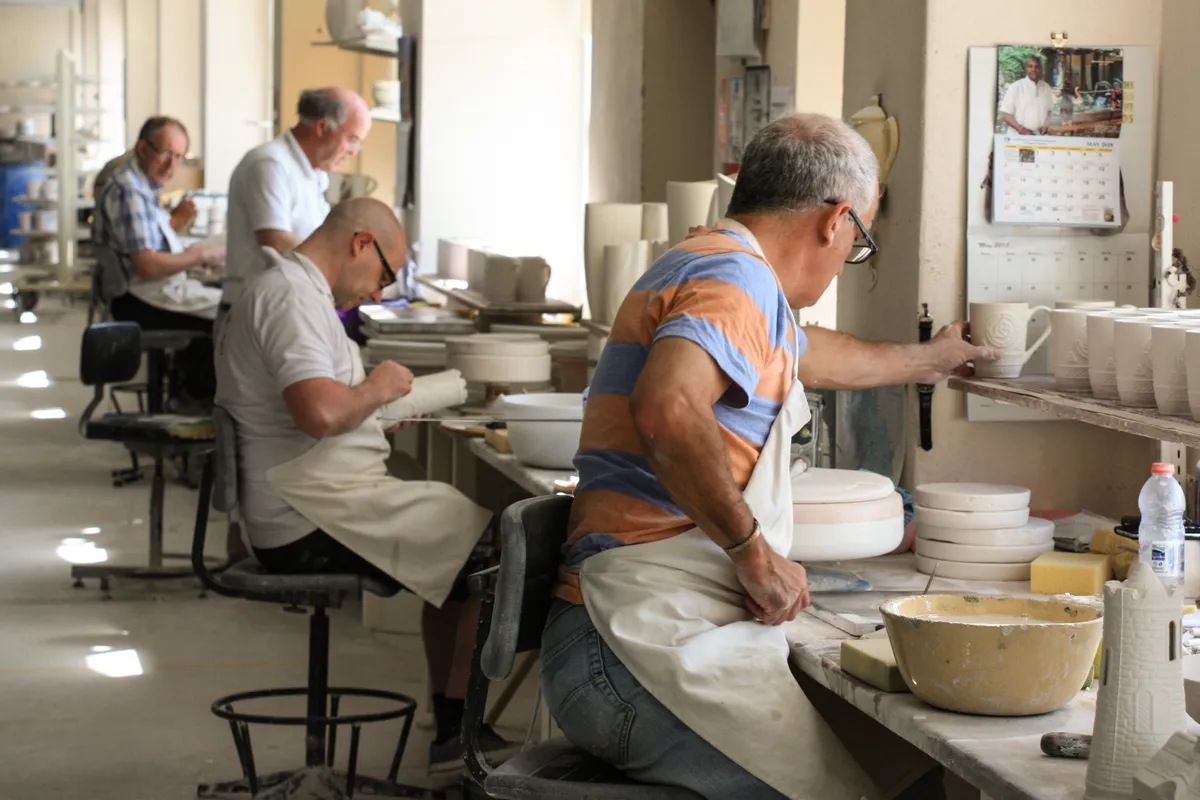
At the heart of Belleek village is Belleek Pottery, a neo-Georgian building home to Ireland’s oldest working fine china company, established in 1857. Take a tour of the workshop for £6.
Things to see and do in County Fermanagh – nature and landscape
Marble Arch Caves Global Geopark

In 2004, the Marble Arch Caves Global Geopark became part of the Global Geoparks Network, an organisation that aims to promote and conserve the geological heritage of a region while supporting local communities through sustainable tourism. The park comprises the magical Marble Arch Caves, along with much of the land in Fermanagh’s west. Explore Lough Navar Forest on a 10km scenic drive beneath its conifer canopy to one of Ireland’s most dramatic vistas, the Cliffs of Magho. The limestone escarpment can also be reached via a steep one-hour hike from Magho Jetty.
Cuilcagh Mountain
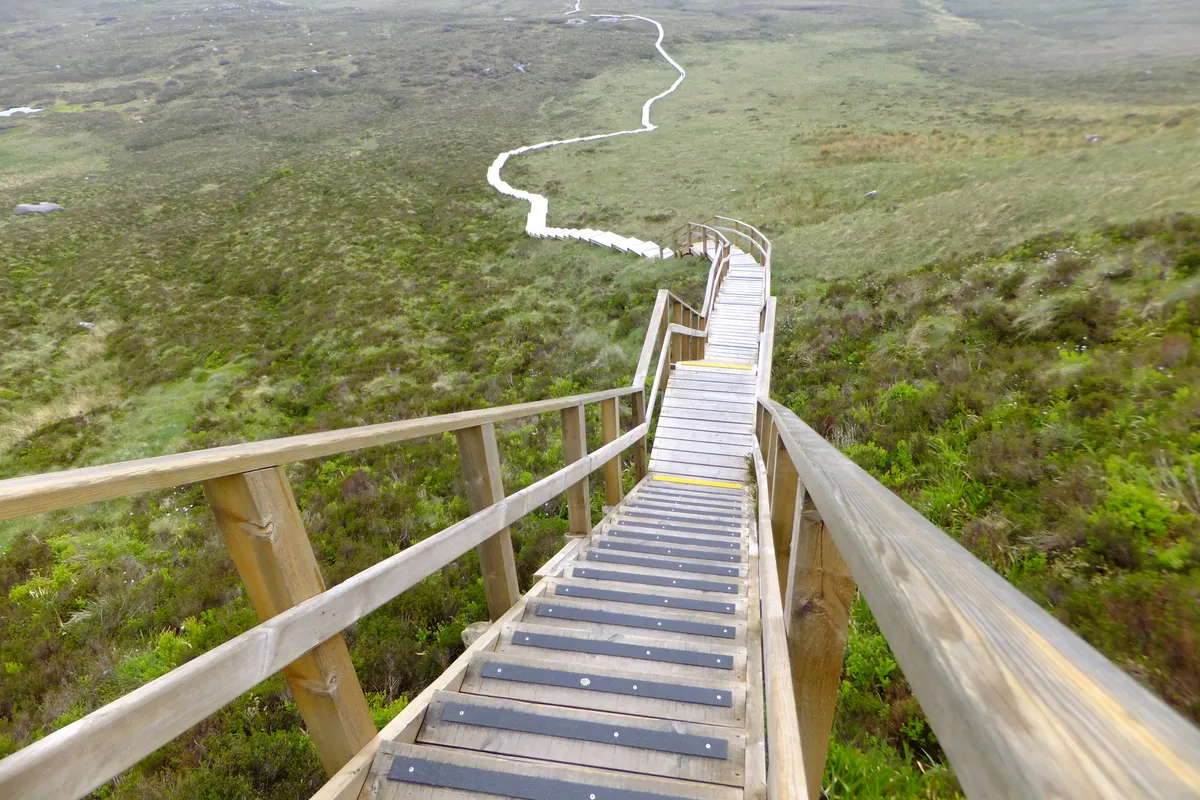
At 655m, Cuilcagh Mountain is the highest point in Breifne Mountains and County Fermanagh. The summit can be reach via a snaking boardwalk, leading hikers to the summit without harming the surrounding landscape, which is home to both montane heaths and the rare golden plover.
Hanging Rock, Lough McNean Lower
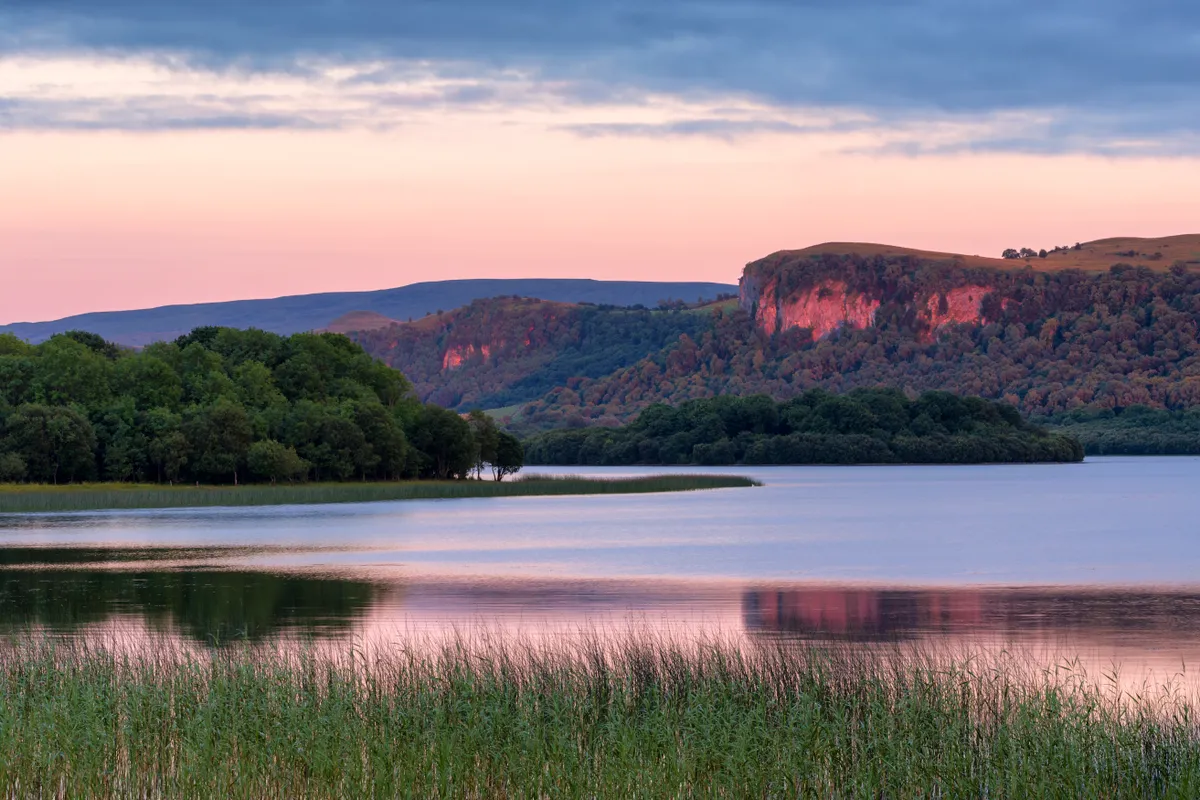
The salient profile of Hanging Rock stands proud above Lough MacNean Lower, one of dozens of waterways in County Fermanagh. This huge limestone cliff is best viewed from the north-eastern side of the lough where a lay-by offers a convenient place to stop and capture the scene through a lens.
Cliffs of Magho
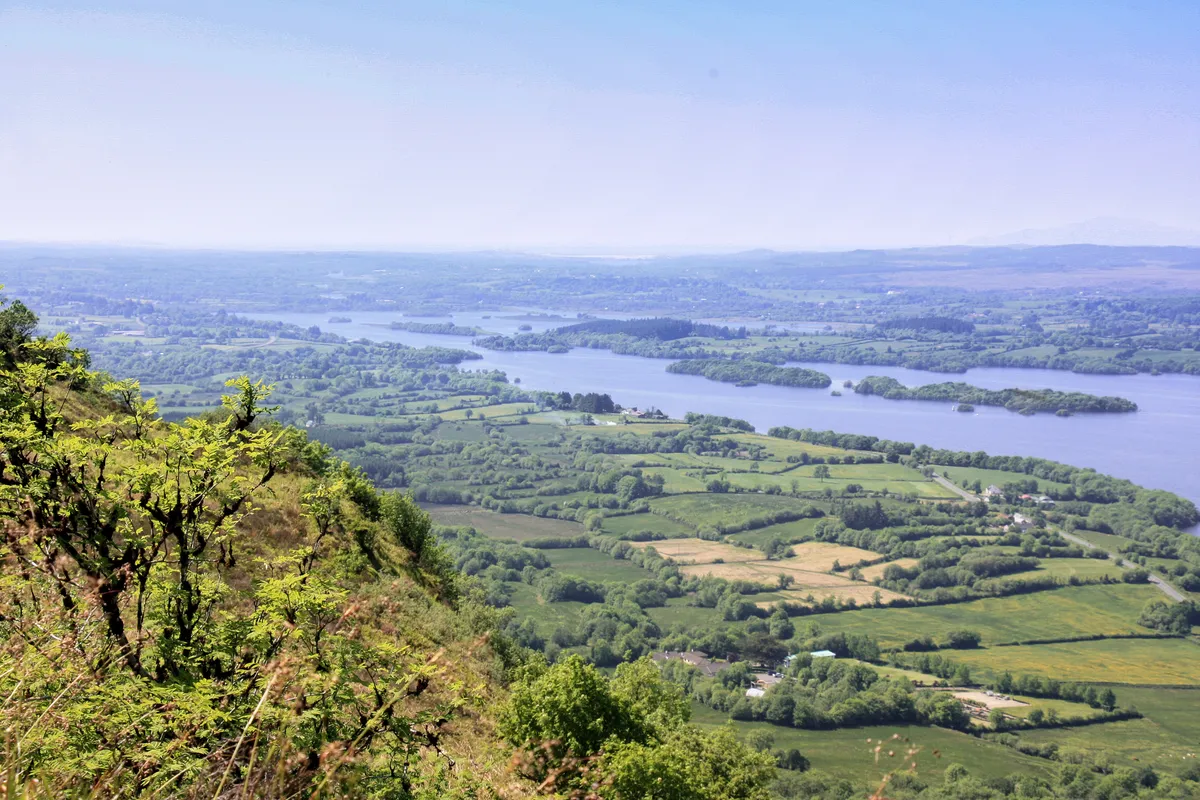
Heightened perspective: the 230m-high Cliffs of Magho offer spectacular views across Lower Lough Erne to the distant Blue Stack Mountains. The viewpoint can be reached via the beautiful Lough Navar Forest Drive, just off Glennasheevar Road to the east of Belleek. Those feeling more adventurous can climb from from Magho Jetty on the lough shore on a steep, mile-long path.
Lough Navar Forest Drive

Lough Navar Forest comprises bog, heath, native forest, conifer woodland and open water, including the beautiful Parabaun Lough. A 10km scenic drive wends beneath its conifer canopy to one of Ireland’s most dramatic vistas, the Cliffs of Magho.
Lough Erne boat trips
Erne Water Taxi
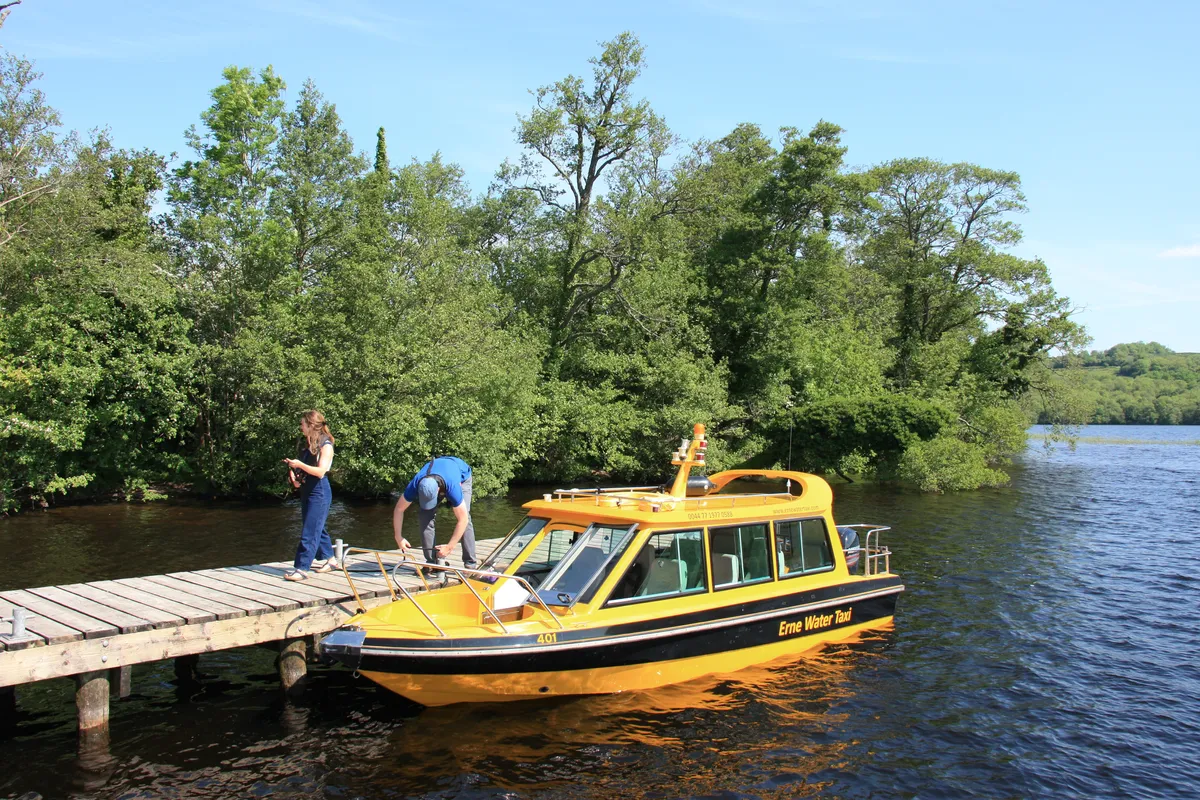
Looking for something with zip and flexibility? Barry and Helen Flanagan’s eight-seater water taxis (left) pick up and drop off from any accessible jetty, making them perfect for small groups and wildlife lovers. Choose from a range of tours, including the Quick Blast, the Lough Erne Expedition and the Lough Erne Food Trail; £70 per hour. 0771 977 0588, ernewatertaxi.com
Share Discovery Village
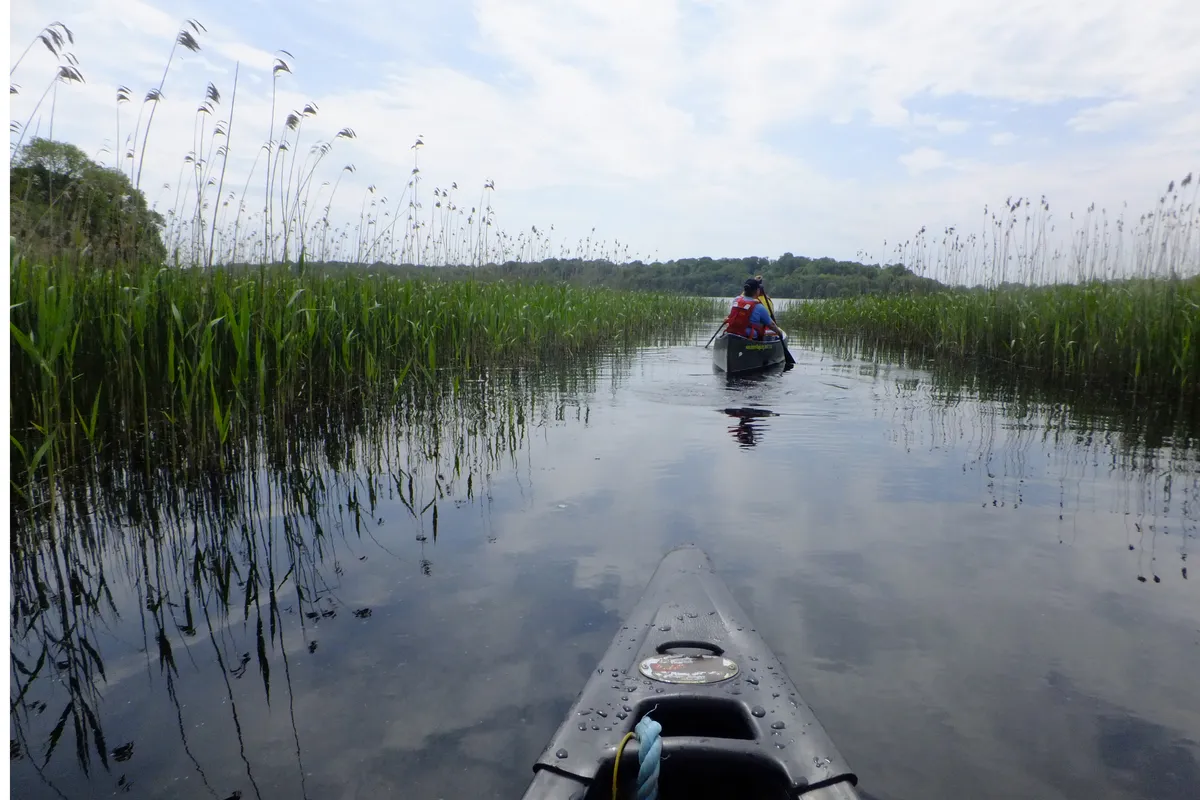
For a more hands-on adventure, grab a canoe or kayak from Share Discovery Village on the eastern side of Upper Lough Erne and explore the loughs at your own pace. Hire a boat for an hour (from £10) or take on a three-day guided canoeing trip, stopping overnight at the remote Trannish Island bothy; £145pp. 0286 772 2122.
Hare Krishna Ferry
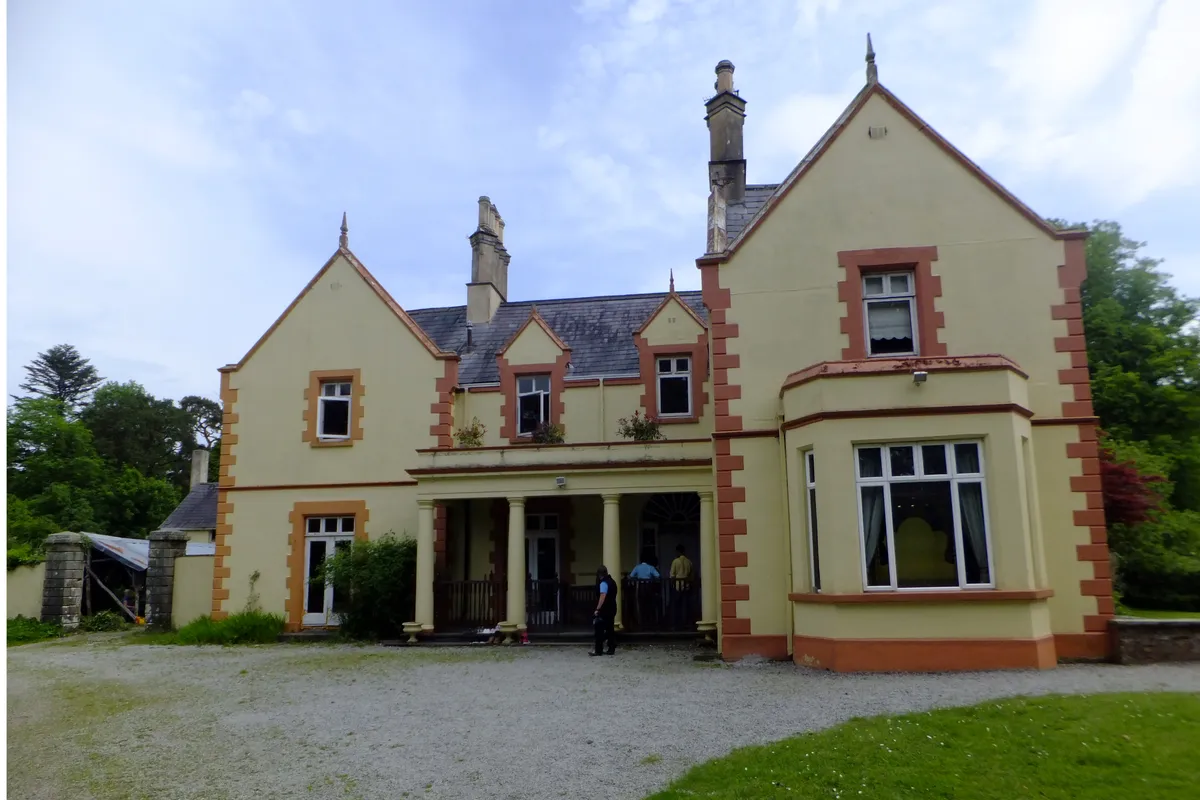
Inis Rath, or Hare Krishna island, is open to the public throughout the week, but you’ll need a boat to get there. The best time to visit is on Sunday when a free ferry service takes visitors to the island reserve from Geaglum Quay on Upper Lough Erne’s western shore. Time your visit with the ‘Sunday Feast’ and take part in congregational chanting, a Q&A session and a vegetarian banquet. 0286 772 3878.
Erne Tours Ltd
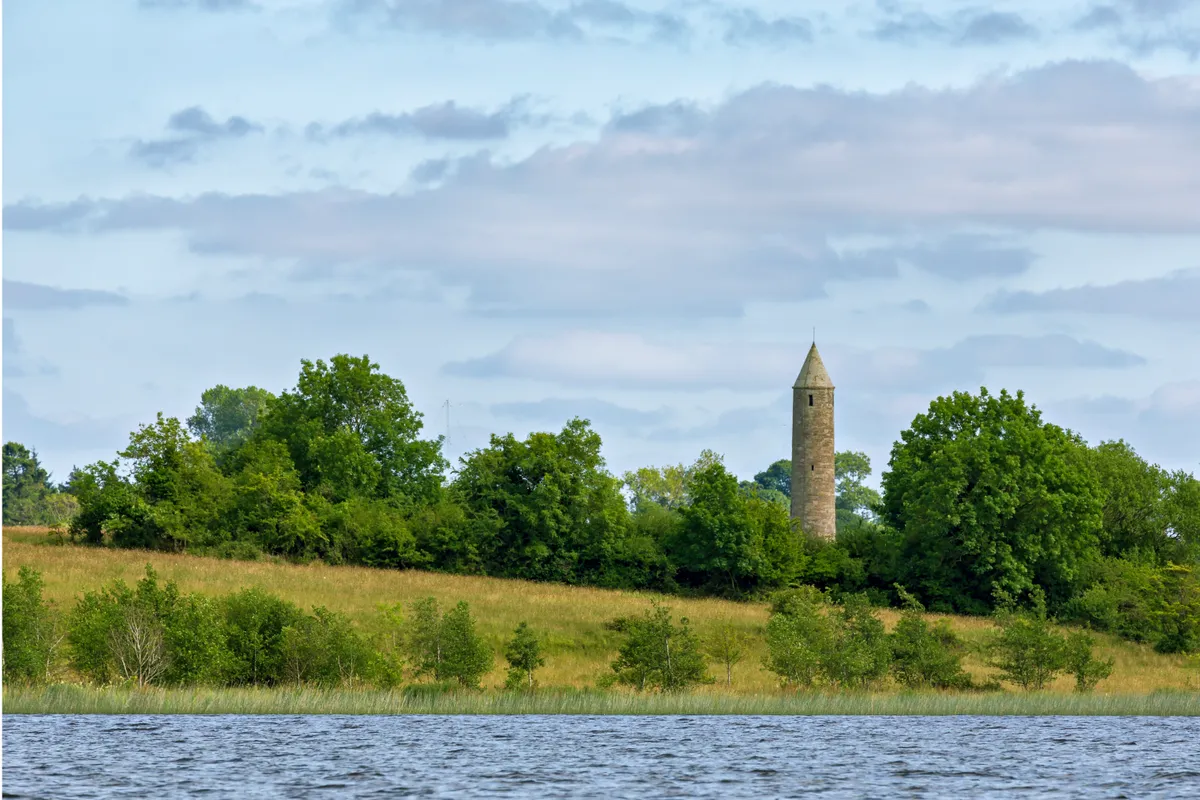
Enjoy live commentary on board MV Kestrel as the boatmaster navigates the waterways around Enniskillen before heading out across open waters to Devenish Island, home to one the UK’s finest monastic sites. The 56-seater waterbus offers regular tours lasting one hour and 45 minutes; £10pp. 0286 632 2882, ernetours.com
Places to eat and stay in County Fermanagh
The Watermill Lodge, Kilmore Quay
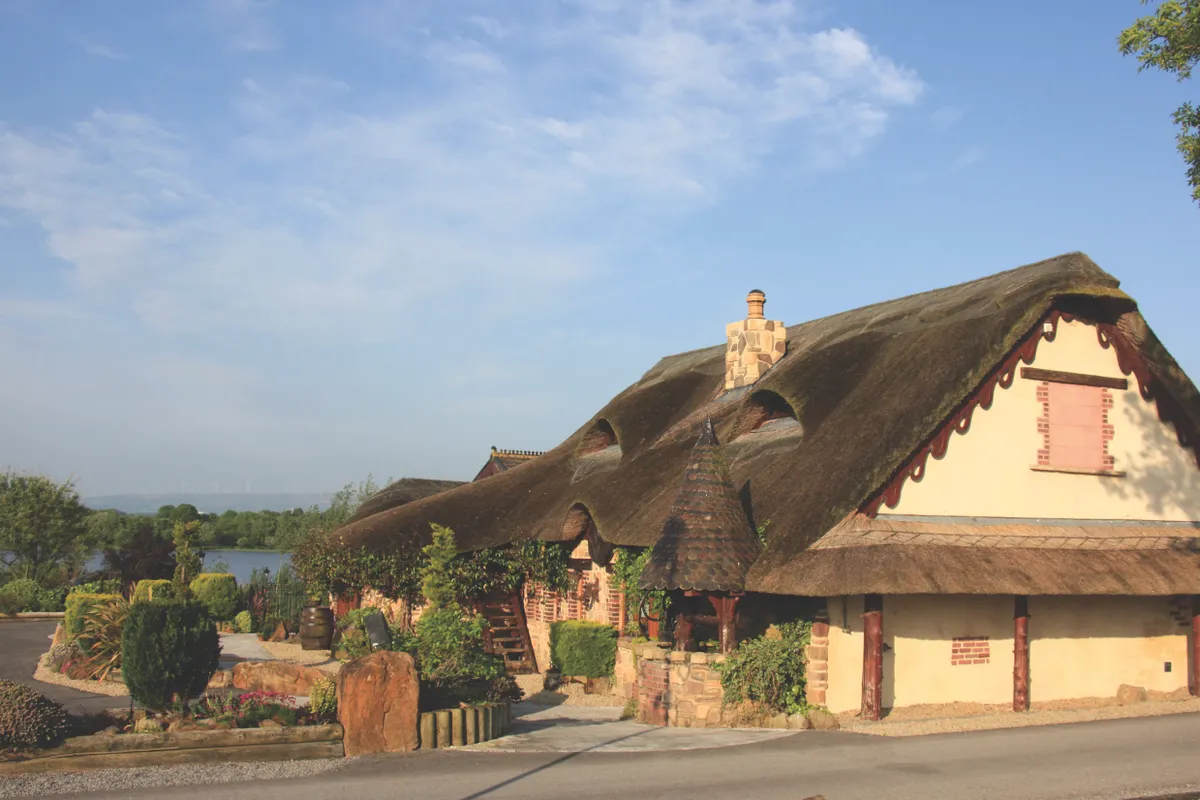
Ever tried Irish cuisine with a French twist? Chef Pascal Brissaud at The Watermill Lodge offers just that. Enjoy an early bird or à la carte menu with an after-dinner digestif, then head out for an evening stroll along the wildlife-rich shores of Upper Lough Erne. The lodge has seven en-suite rooms with lake and garden views. Despite their opulent décor, stays are affordable (£99 for a double room and breakfast) and perfect for families, couples and individuals alike. 028 6772 4369.
Crom Estate, Newtownbutler

Explore the ancient woodland, freshwater habitats and rare wildlife of the National Trust’s Crom Estate in the south of Fermanagh, then set your tent up in the estate’s back-to-basics campsite. The family friendly site has a shower and toilet block and a communal fire, plus a collection of stone-built glamping pods; from £20 for a two-person tent. 0286 773 8118.
Finn Lough Resort, Leggs

This luxuriant resort has a choice of accommodation, from lakeside cottages and lodges to catered suites and even forest bubble domes. Take a mountain-bike ride through the forest, relax by the water’s edge with a campfire, head to the spa, then dine in the restaurant on fresh, seasonal food, grown in Finn Lough’s own polytunnel; from £160 for a suite for two. 0286 838 0360.
Lusty Beg, Boa Island
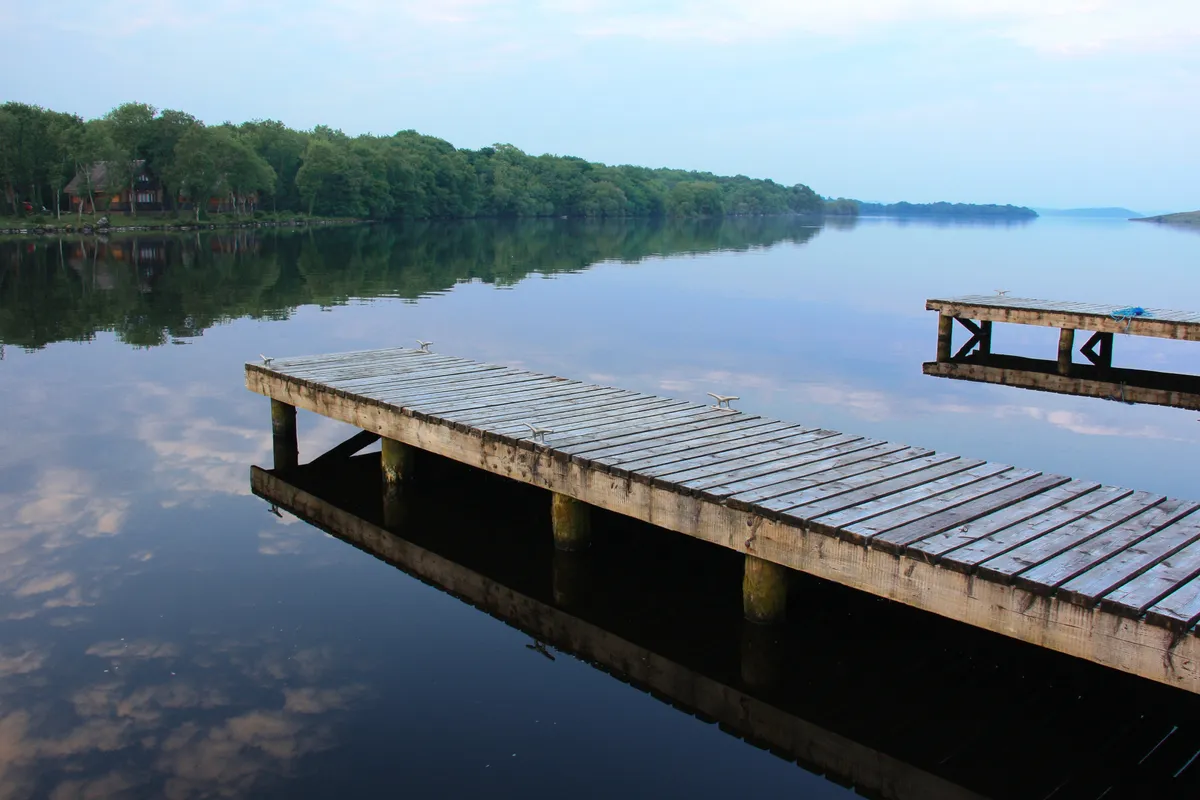
Island adventures don’t come much more magical than a trip to Lusty Beg, a tiny, wooded islet set adrift from the larger Boa Island in the north of the lakes. Book a waterside cabin or the Inish Lodge and spend the night at the rustic Island Restaurant. Discover the enchanting Fairy Trail, try your hand at archery or relax at The Island spa; from £95 for B&B for two. 028 6863 3300.
Wildlife in County Fermanagh
These nutrient-loaded wetlands create ideal conditions for the growth of fen peats, reedbeds, wet grasslands and woodlands, which in turn provide a home for mammals, insects, birds and, perhaps most notably, fish. Perch, bream, roach and pike proliferate, along with one or two more curious species, not least ferox, gillaroo and sonaghan trout.

In springtime, bluebells, wood anemones and the creamy petals of toothwort colour the forest floors around the loughs; the warbles and trills of blackcaps and wood warblers resonate through the canopies, and red squirrels leap like uncoiling copper springs from branch to bough. And all the while the scent of spring – of pollen, boot-trodden grass and rain on dry ground – seldom fades.
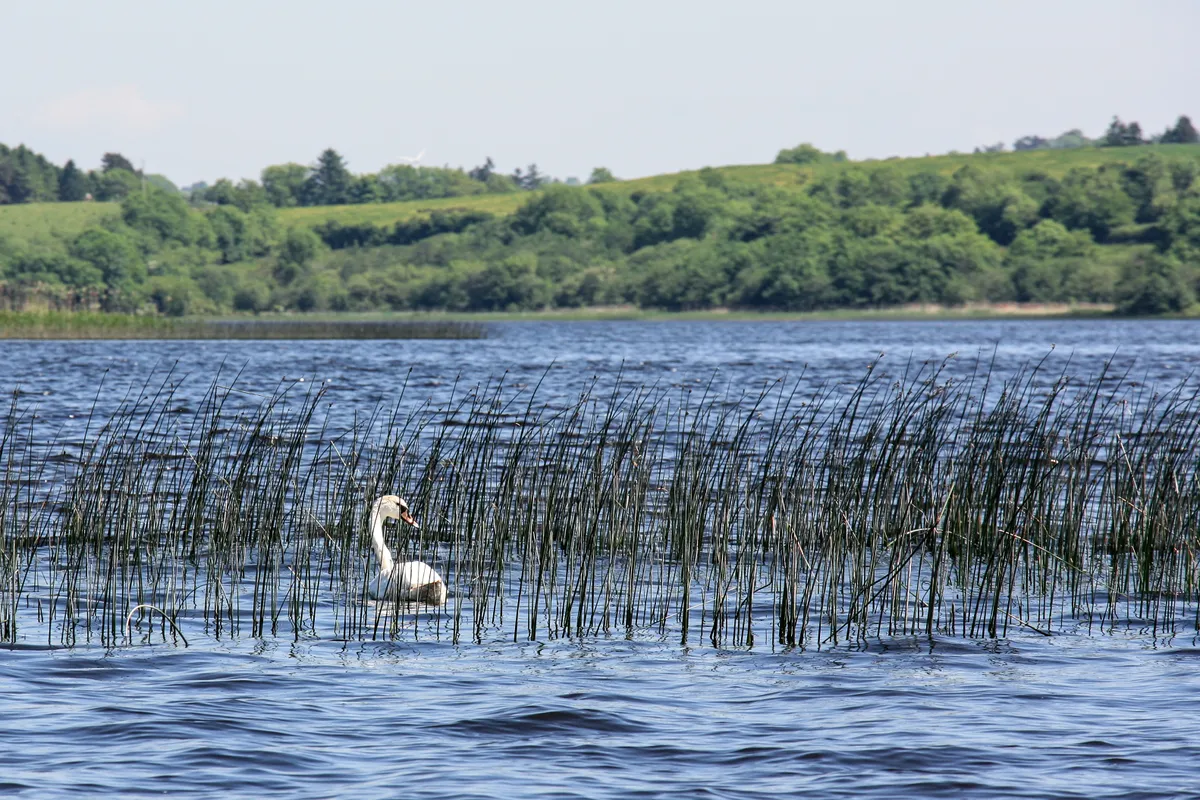
Low-intensity farming sees the grasslands flourish with yellow rattle, buttercups and meadow vetchling, while montane heaths, found most notably on the slopes of Fermanagh’s highest peak, Cuilcagh Mountain (665m), provide a home for the rare golden plover. And then there are the caves – miles and miles of stream-run passages, vertical shafts and great rocky chambers, home to freshwater shrimps, bats and the occasional frog.

The forgotten lakes of Fermanagh
A blog post by BBC Countryfile Magazine section editor Daniel Graham
Midway between the Irish border towns of Pettigo and Belleek is a meadow. Deciduous trees with knotted trunks and blinking leaves hedge the pasture on all sides except the south, where the lucid greens and golds of the land roll down to the gunmetal greys of a great lough. The low sun shines, warm but not hot, as the water breathes rhythmically over the pebbles on the shore.
Not far from the water’s edge, the grass twitches and bows beneath the weight of something rooting through the soil. A cloud of small May-time insects, startled by the commotion, escapes into the air, their wings catching and dispersing the early morning light. And then it appears, its little heart-shaped head set upon slender, cappuccino-coloured shoulders. It’s a pine marten, the first I’ve ever seen, and moments later it has gone, slinking slowly into the undergrowth with a flutter of its long, lustrous tail.
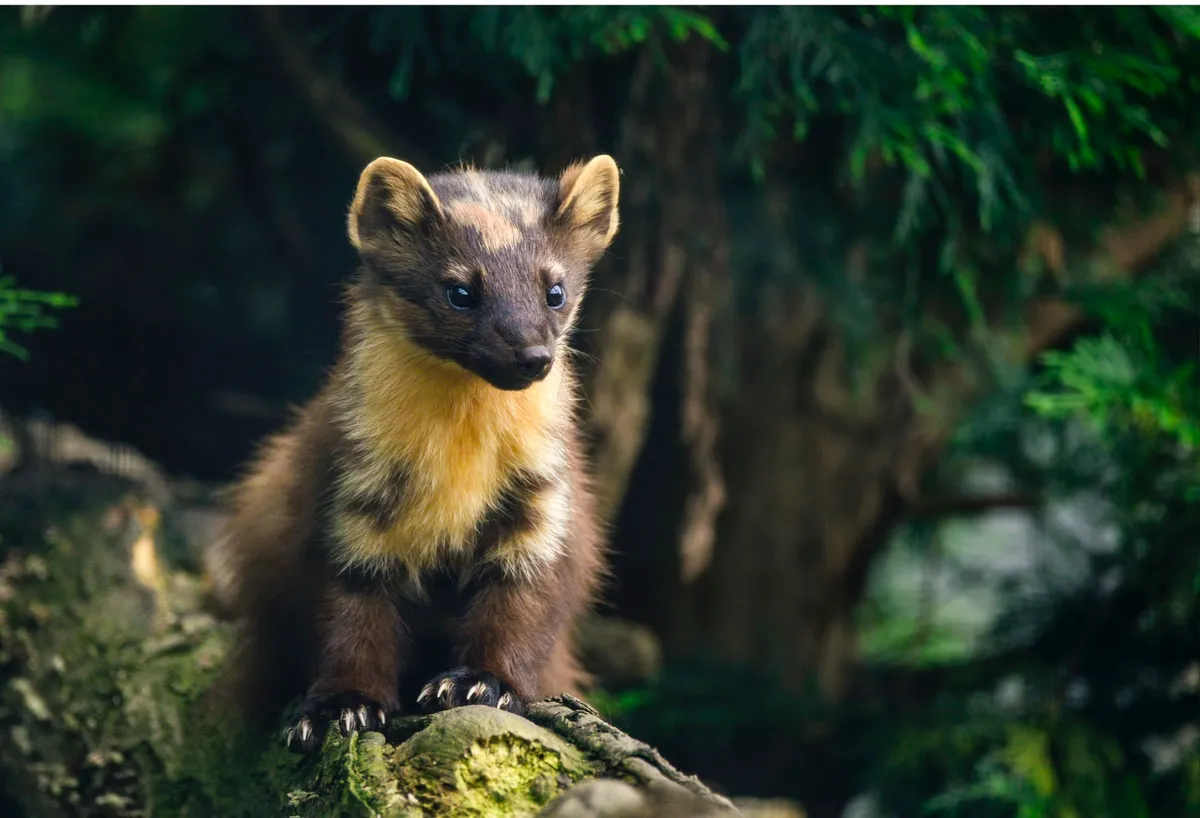
Secretive though these mammals may be, there are signs of them throughout Northern Ireland’s forgotten lakes. Like many animals, they find peace in the untainted woodlands and fertile meadows that wrap the shores of mighty Lough Erne and its surrounding meres.
A year of islands
It’s late spring, and in spite of Northern Ireland’s reputation as a land of ceaseless rain, the skies are blue and the countryside rejoices in life; birds chirrup and chatter in the billowing tree canopies, cows graze the fresh green fields and iridescent butterflies nip from flower to flower.
I drop my paddle into the glassy waters of the lough and pull it across my body, watching an eddy roll off the back of the stroke like a spinning top. My partner Maria is our engine for the day and, distracted by her energetic heave-hos, she’s blissfully unaware that I’m not really pulling my weight. I take advantage and watch a second swirl rise to the surface then drift off in our wake.
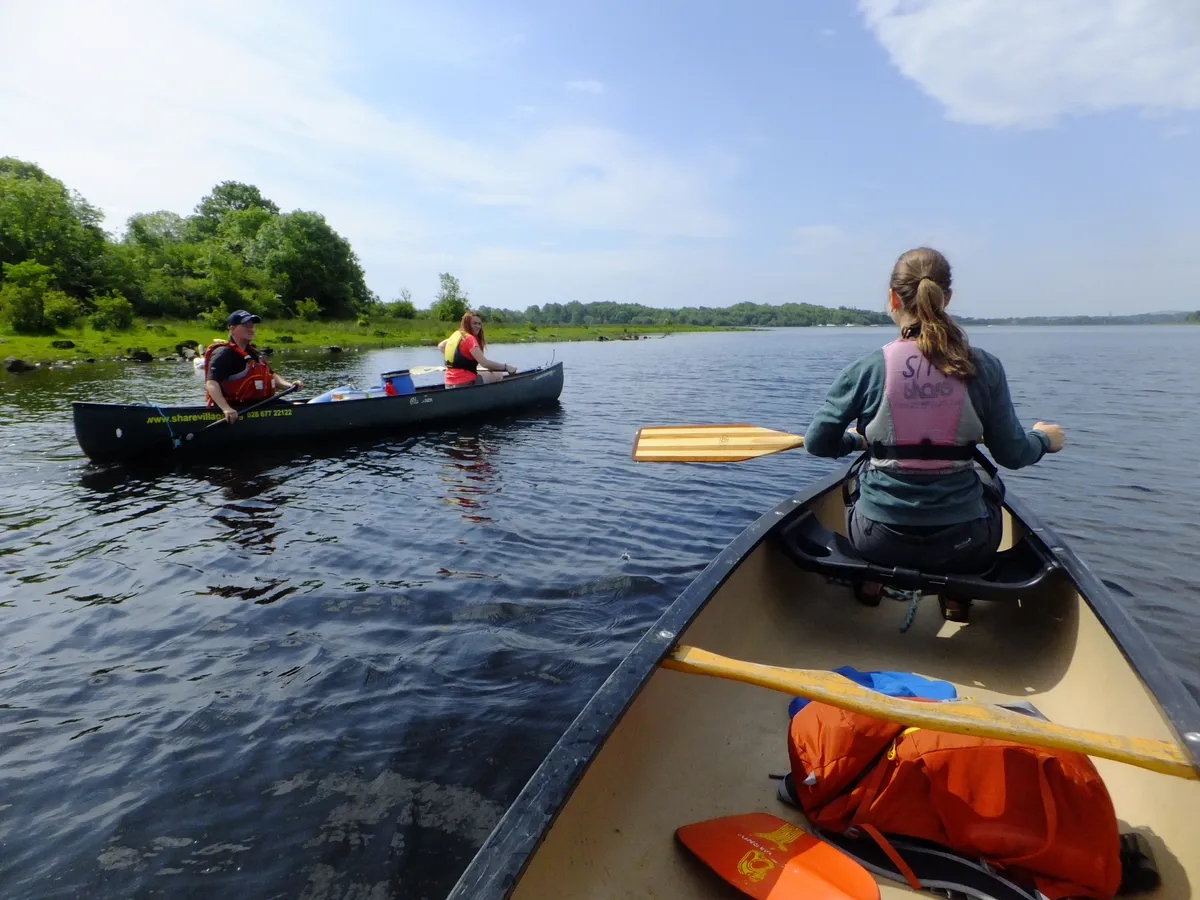
“They say Lough Erne has one island for each day of the year,” our guide Elaine Alexander – known to everyone as ‘Shooter’ – calls across the water. “There are actually 154, some no more than a tree on a boulder, others several miles long with their own roads.” Suddenly a fish blasts from the lake – its body muscular and writhing, freckled yellow, juniper-green and an off shade of white. “Pike,” Shooter assures, before turning her gaze to an island half-lost in the heat of the day on the opposite side of the lough. “We’re aiming for that.”
A few minutes later we arrive at Inis Rath, more commonly known as Hare Krishna Island. We hitch the boats to the jetty and climb through tangled rhododendron and sweet-scented pines, emerging moments later to the sight of a grand Victorian mansion at the head of a sweeping glade. The building was once a hunting lodge, built in 1854 by Sir Henry Cavendish Butler, but in 1982, a group of Hare Krishna monks bought the island. It is now a place of tranquillity. The exotic cry of a peacock echoes through the kitchen gardens, deer forage along the wood’s sun-warmed verges and the mansion’s west wing, now a temple devoted to Lord Krishna, sings with the heady smell of incense and the call for prayer.
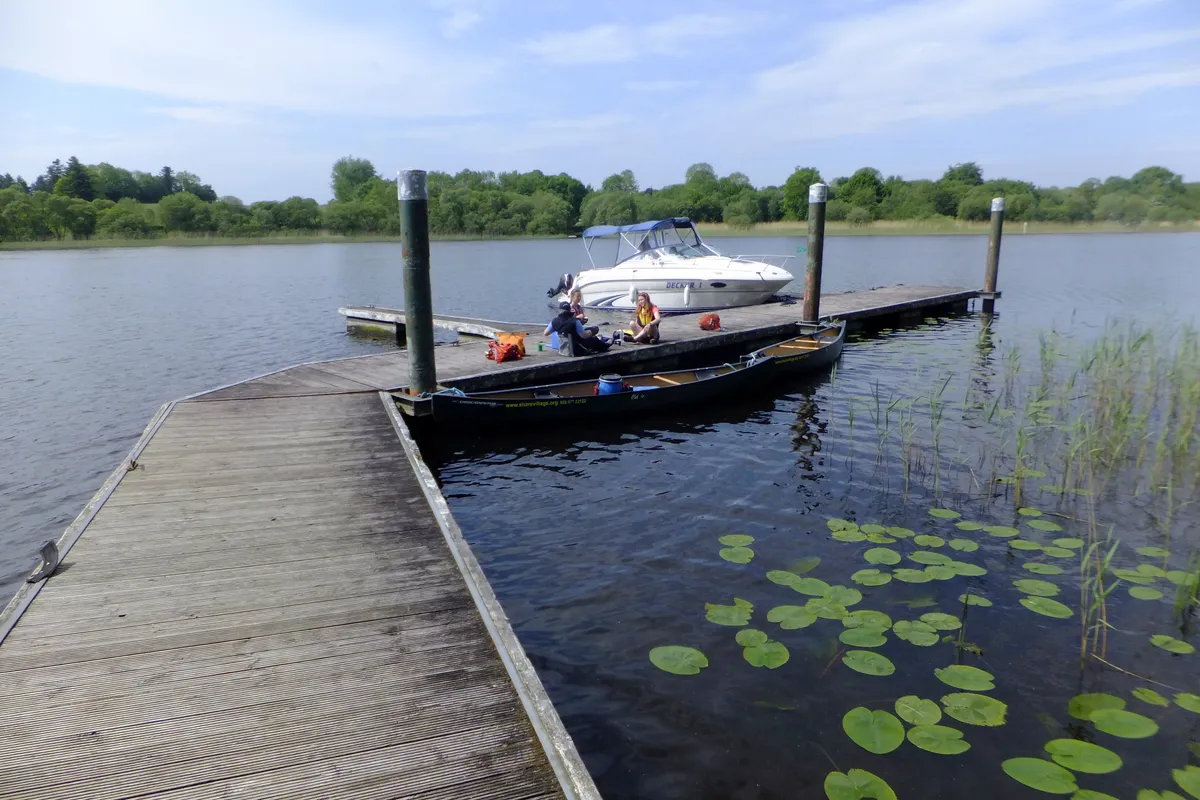
We leave the house and spend the rest of the day paddling from one island to the next – past Dernish and its sylvan sibling Crehan, through narrow tunnels of hissing reeds and around tiny Gad Island, accentuated by the round, castellated folly of Crichton Tower. By mid-afternoon, after passing the National Trust’s Inisherk Island, we arrive at the 2,000-acre demesne of Crom Estate and haul our boats ashore.
Seven hours on the water, seven islands covered. By my calculations, we would need another three weeks to see the rest. And that’s not to mention the lough’s countless bays, waterside nature reserves and the walking trails that hem the shores of this immense water world.
Ireland’s Amazonia
A day later and we’re out on the water again; this time with Barry Flanagan on Lower Lough Erne – deeper, broader and wilder than its neighbour. Our small, motor-powered vessel zips across the water like a shearwater, blurring our surroundings to a palette of soft greens, blues and yellows. We spot a kingfisher. A pair of grebes. A raft of ducklings tailing their mother. And more islands, bound with deciduous trees with exposed roots that sink into the water like mangroves. Northern Ireland’s Amazon, perhaps, but without the piranha.
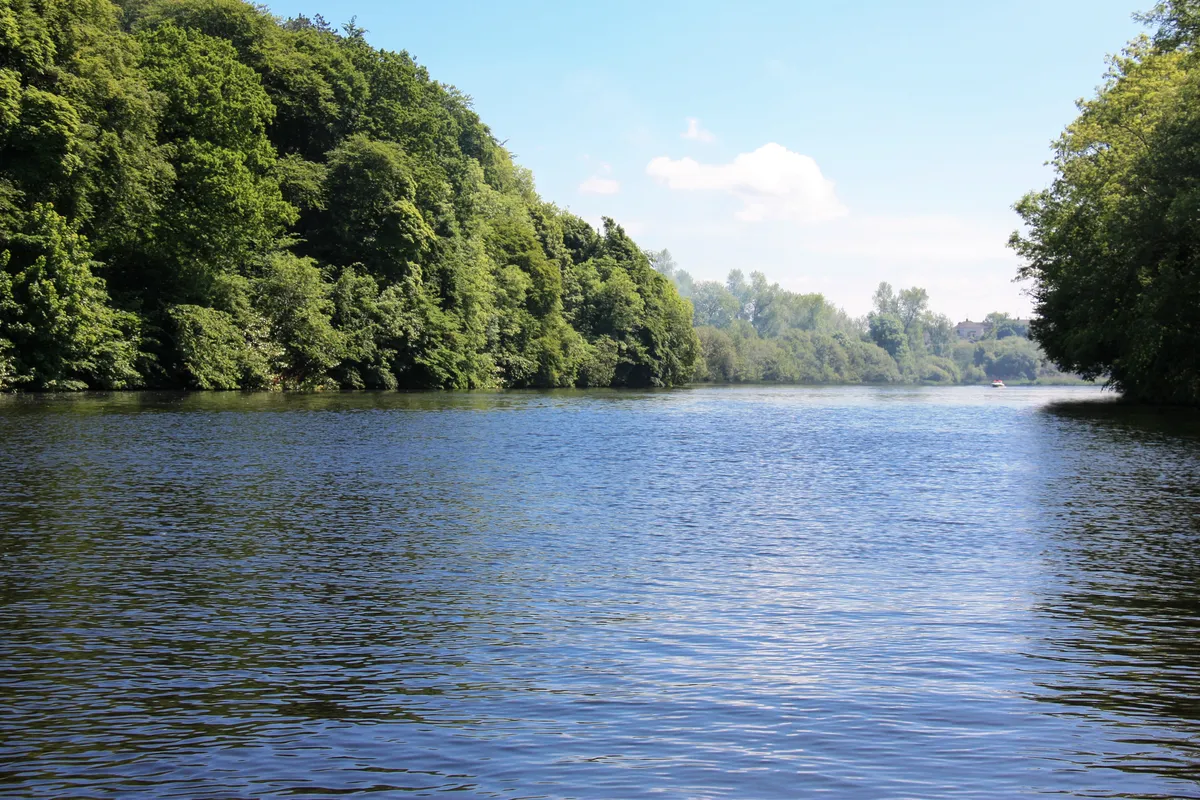
“A few hundred years ago, Ireland was one huge forest,” Barry tells us from the helm. “Only four per cent of it is left but it feels like it’s all here in Fermanagh.
“Most of the islands, even the really small ones, were inhabited until quite recently,” Barry adds. “People built homes from the trees, fished the loughs, drank their waters, travelled by canoe. But the lure of modern life was too great for most, and on days like this it can feel like you’re the only one out here.”
Barry cuts the engine and we splutter to a stop, rocking from side to side two miles from solid ground. “Come here at night,” our skipper says, “and the stars are something else. Wait long enough, and you’ll see the Northern Lights.”
Upper and Lower Lough Erne dominate Fermanagh, but a quick scan of the map reveals at least 60 more waterbodies – endless scope for slow discovery. We spend the next few days drifting through the county, from the woods and water of Lough Navar Forest in the north to the drama of Lough MacNean Lower, half-shadowed beneath the enormous limestone bulk of Hanging Rock.
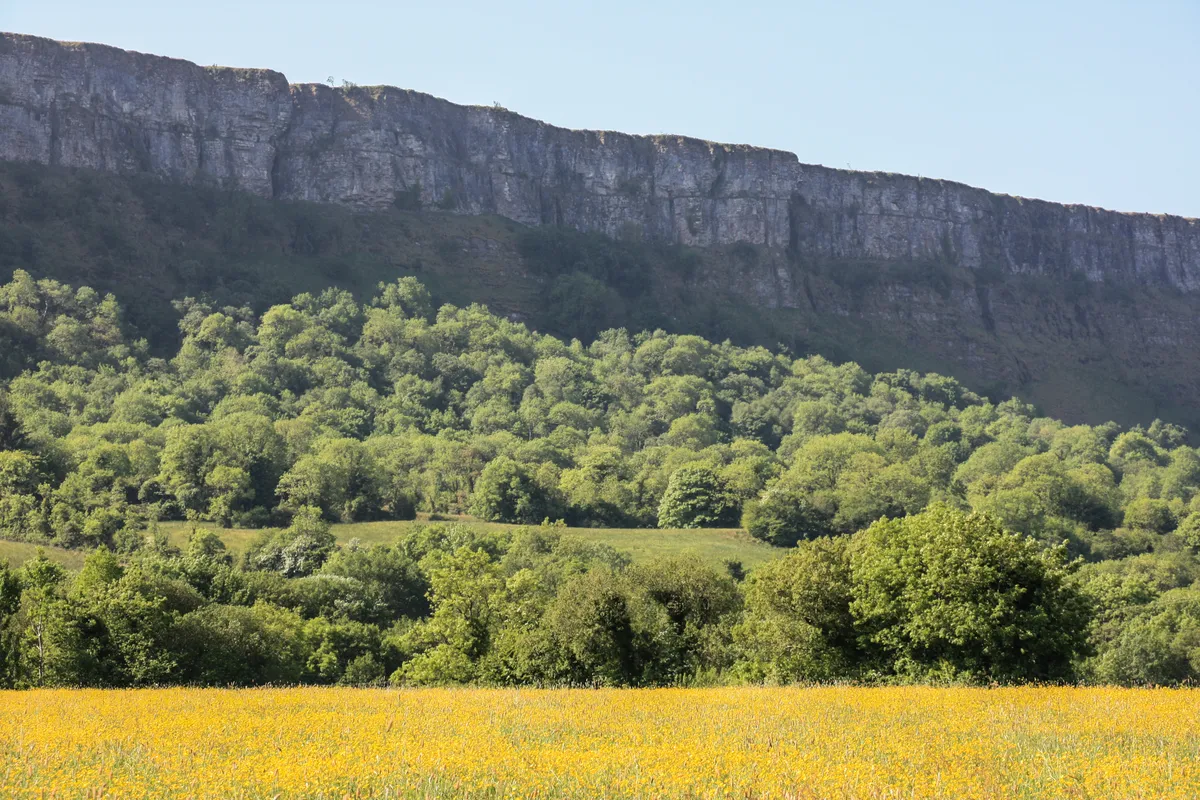
A land long-lived
Hidden within Fermanagh’s bounty of life lies evidence of an extensive and often volatile past: a densely fused concoction of saints and pagans, clans and earls.
Head to the northern extremes of Lower Lough Erne and you will run aground on the shores of five-mile-long Boa Island. Here, concealed among wrestling hawthorns and the lichen-spattered headstones of Caldragh Graveyard, stand two stone figures – Janus and the Lustyman – thought to date from the early Christian period (400–800 AD), some 1,500 years ago. From here, drift south to White Island and you’ll discover more relics, this time six stone figures and the crumbled walls of a 12th-century church. Beyond that is Devenish Island, one of the finest monastic sites in the UK, founded in the 6th century by Saint Molaise on a pilgrimage to County Mayo.
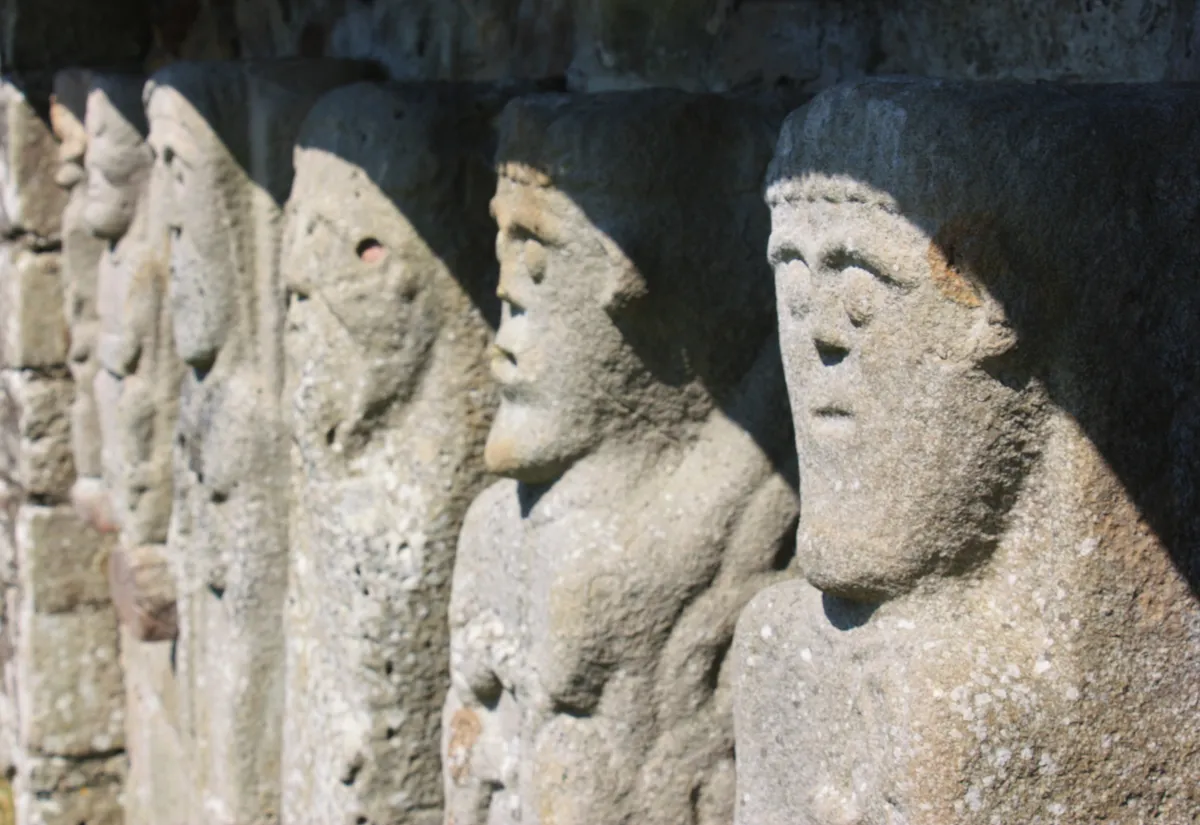
Nearly 1,000 years later, in 1428, Hugh ‘the Hospitable’ Maguire built a castle at the strategically significant pinching point between Lower and Upper Lough Erne, now the core of Enniskillen. The ensuing centuries witnessed numerous Irish rebellions against English rule, then, in the late 1960s, following a series of civil rights protests and riots, the Troubles erupted.
Today, Enniskillen’s shops, cafés and oak-walled inns make it the beating heart of the county, and a convenient place from which
to explore the loughs. Visit nearby Florence Court – an 18th-century Georgian estate with beautifully maintained kitchen gardens and parkland – or explore the grandeur of Castle Coole’s neoclassical house and surrounding wooded grounds. Those seeking a little more solitude and charm may prefer to base themselves in the border village of Belleek in the north, renowned for its historic china factory and its fishing.
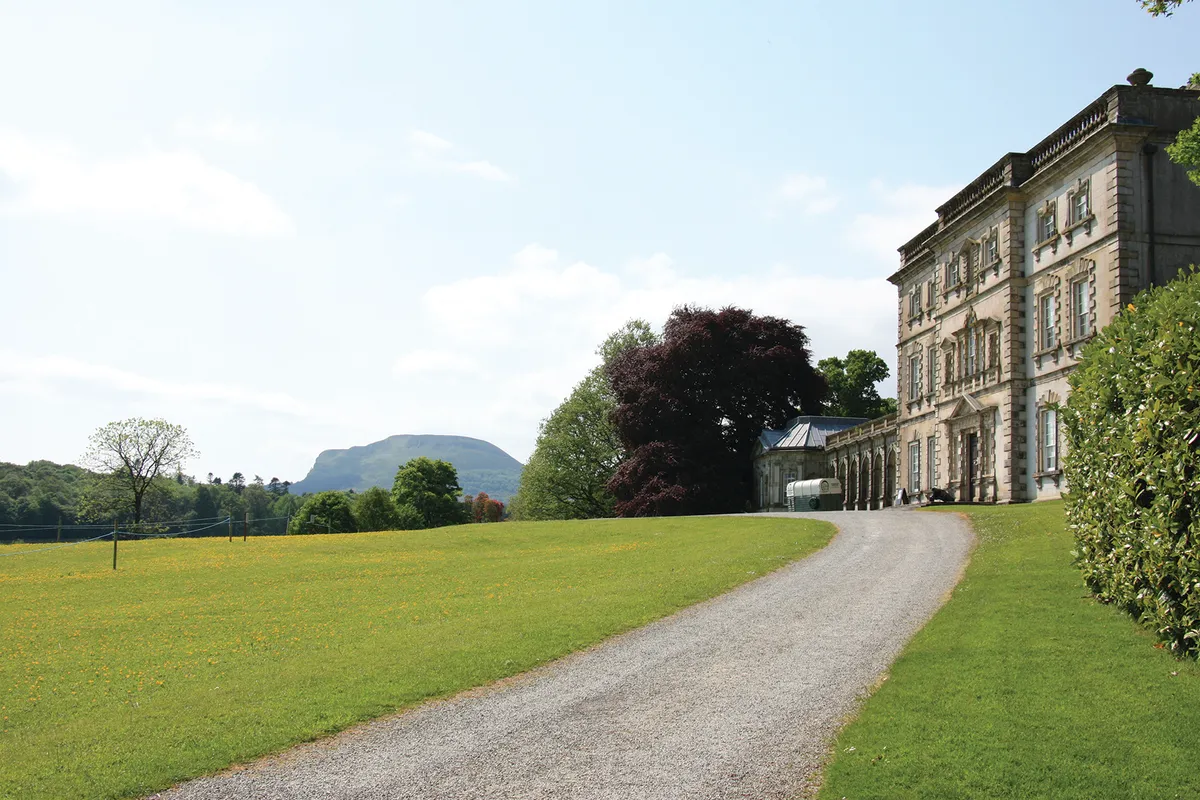
Either way, it’s time and slow travel that prove to be your true virtues here in Fermanagh’s forgotten lakes. Few words encapsulate the region better than those of Enniskillen poet Francis Harvey: “Fermanagh, half in and half out of whatever its element is. Never quite sure at any time whether it’s one thing or another, land in water or water in land.”

